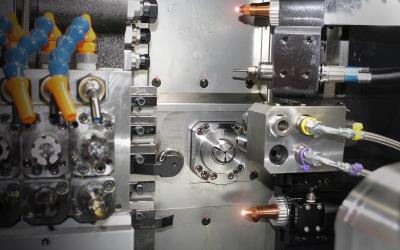
Tsugami Automation's new Tsugami CNC Swiss Turn, the SS207-5AX LaserSwiss, is a 20 mm, 7-axis CNC Swiss Lathe with two fully integrated SPI lasers, one for cutting and one for welding. The machine is the latest model in the company’s LaserSwiss product line, and the first to include a second laser head for welding.
“The addition of the second laser head for welding is huge,” Tsugami Automation Business Development Director Dan Walker said. “Users can now essentially replace three machines with one and perform very complex, dissimilar operations with a single setup. The range of capabilities this machine offers is unprecedented.”
For example, Walker noted, the laser welding head not only allows users to weld two pieces together, then machine them, it allows operators to reflow a swaged tube end.
The laser cutting and welding heads can be mounted on either the X/1, Y/1 or B axes, and all operations are programmed and driven from the machine’s FANUC 32i-B control. The nozzle standoff adjustment is also NC-controlled, and each laser’s frequency, pulse width, focus and power are all on-the-fly adjustable and programmed through the machine’s control.
Users can also adjust the assist gas pressure from 5 to 350 psi, allowing different pressures to be used for piercing and cutting, as well as the very low gas pressures typically used in welding. Wattage on the lasers can range from 20 to 750, depending on the customer’s preference.
“As soon as I mention that our new LaserSwiss has welding capabilities,” Walker said, “Everyone says it’s a game changer.”
Contact Details
Related Glossary Terms
- computer numerical control ( CNC)
computer numerical control ( CNC)
Microprocessor-based controller dedicated to a machine tool that permits the creation or modification of parts. Programmed numerical control activates the machine’s servos and spindle drives and controls the various machining operations. See DNC, direct numerical control; NC, numerical control.
- lathe
lathe
Turning machine capable of sawing, milling, grinding, gear-cutting, drilling, reaming, boring, threading, facing, chamfering, grooving, knurling, spinning, parting, necking, taper-cutting, and cam- and eccentric-cutting, as well as step- and straight-turning. Comes in a variety of forms, ranging from manual to semiautomatic to fully automatic, with major types being engine lathes, turning and contouring lathes, turret lathes and numerical-control lathes. The engine lathe consists of a headstock and spindle, tailstock, bed, carriage (complete with apron) and cross slides. Features include gear- (speed) and feed-selector levers, toolpost, compound rest, lead screw and reversing lead screw, threading dial and rapid-traverse lever. Special lathe types include through-the-spindle, camshaft and crankshaft, brake drum and rotor, spinning and gun-barrel machines. Toolroom and bench lathes are used for precision work; the former for tool-and-die work and similar tasks, the latter for small workpieces (instruments, watches), normally without a power feed. Models are typically designated according to their “swing,” or the largest-diameter workpiece that can be rotated; bed length, or the distance between centers; and horsepower generated. See turning machine.
